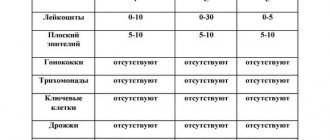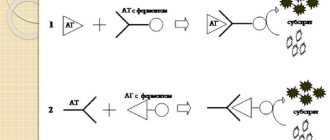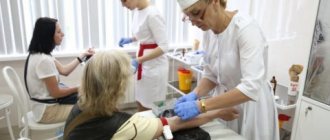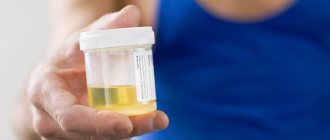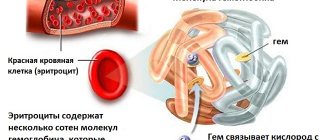A PSA test allows you to suspect the presence of prostate cancer without TRUS, biopsy and MRI, but in some cases men receive a false positive or false negative result. In this article we will tell you what the test is and how to prepare for taking it so that the result is reliable. We will also present the factors that influence the indicator and explain in detail at what values there is a serious cause for concern.
What is a PSA test in men?
PSA is an abbreviation for the protein that stands for prostate-specific antigen. It is produced by prostate tissue and is present in the body of any man who has not undergone a prostatectomy. If the concentration of this protein in the blood begins to exceed standard values, then there is reason to suspect a prostate tumor, but not necessarily malignant.
Accuracy
A PSA test in most cases does not accurately confirm or refute the presence of prostate cancer. The problem is that the patient, having received the result within the normative limits, usually calms down, refuses further examination, but the tumor is actually present. Another option is possible - an increased value greatly frightens a person when everything is not so scary. There is no need to panic in advance, since the diagnosis of cancer is confirmed only in 1/3 of all cases.
Types of PSA
Total PSA : the protein circulates in the blood in two forms - bound and free. Their totality constitutes the total PSA.
Free PSA : This is a protein in its unbound form. Normally, free should be at least 15% of the total. If the concentration of bound PSA increases, there is reason to suspect prostate cancer. With hyperplasia, the proportion of free PSA increases.
What is the difference between total and free PSA : total PSA includes free. This form of protein is not associated with the plasma proteins alpha-1-chemotrypsin or alpha-2-macroglobulin. A relatively accurate picture is given by the ratio of total and free protein - the PSA index. In this way, cancer can be distinguished from other prostate pathologies. Index formula:
PSA-free/PSA-total x 100%
The norm is from 25 to 100%. Interpretation of results with an antigen level of 4-10 ng/ml and a negative prostate palpation result: less than 10% means a high risk of prostate cancer, more than 25% means a low risk.
Indications
A PSA test is prescribed as part of a general medical examination for men over 45 years of age, since prostate cancer does not produce any symptoms for a long time. The antigen protein inhibits the growth and reproduction of pathological cells. The analysis helps to identify a tumor at an operable stage even before the appearance of pronounced signs, as well as monitor the effectiveness of existing treatment and detect relapse.
Indications for a PSA test:
- Complaints of difficult and painful urination;
- Enlargement of the prostate or detection of atypical formations on it during a digital rectal examination;
- Suspicion of a pathological change in prostate tissue based on the results of TRUS (read how ultrasound of the prostate is performed).
Urologist, dermatovenerologist Lenkin Sergey Gennadievich talks about why a PSA test is needed
The result is most informative in dynamics. The indication for a repeat test depends on the initial value:
- 3-4 ng/ml – repeat every 2 years.
- 1-2.9 ng/ml – taken every 2-4 years.
- 0-0.9 ng/ml – it is enough to take the test every 4-8 years.
A rapid increase in antigen concentration indicates an aggressive form of the tumor.
Why is analysis prescribed?
The tumor marker PSA (prostate specific antigen) is a special substance produced by prostate cells. These proteins are found in the prostate ducts to help liquefy the seminal fluid. This study is not carried out in women due to the absence of this organ. Studying the level of the PSA tumor marker helps specialists identify malignant and benign tumors.
Elevated levels of markers may indicate prostate cancer, so this test is recommended for men aged 40 to 50 as a general medical examination. The level of antigen concentration directly depends on the age of the man, therefore, after 50 years, this process to determine the level of PSA antigen in the blood should be carried out regularly every year. The concentration of prostate tumor markers in the blood is significantly influenced by medications and manipulations on the prostate. Also, deviations from the norm are observed in patients who are already undergoing chemotherapy.
A PSA tumor marker test is necessary if prostate disease is suspected. The main reasons why a doctor should prescribe this test to a patient are:
- suspicion of prostate cancer;
- the formation of inflammatory processes in the prostate;
- hyperplasia;
- suspicion of prostate ischemia or infarction;
- preventive examination;
- control over ongoing treatment.
We recommend reading Rea tumor marker: what it means and shows, the norm in women
To analyze prostate proteins, the patient needs to donate blood from a vein. If during a blood test the total indicator exceeds the mark, this does not yet prove the exact presence of oncology in the body, but indicates the need for a more detailed diagnosis using additional diagnostic measures.
Preparing for a PSA test
Which PSA to take - general or free : the reliability of the general PSA is 80%, so you should start with it. If the result exceeds the norm, then both general and free are taken to calculate their ratio. Many laboratories offer a comprehensive PSA test called the Prostate Health Index (PHI). It includes both antigen fractions and their ratio. They also measure the amount of short forms of the protein -2proPSA, the amount of which actively increases in prostate cancer.
Prostate Health Index Formula:
The higher the value, the higher the risk of prostate cancer. The minimum risk is for a value of <23, the maximum for a value of >45. Calculation of the index makes sense when PSA is from 1.6 to 8 ng/ml.
Conditions for donating blood for antigen:
- For 3 hours, do not smoke, drink energy drinks, coffee or alcohol. Avoid physical and emotional stress.
- Eliminate fatty foods from your diet for two days.
- Wait 10 days after prostate massage and any other manipulations on it, including TRUS. After the biopsy, at least 6 weeks should pass, after treatment of prostatitis - at least 8 weeks.
- For 4 days, refrain from ejaculation and cycling (find out whether you can ride a bicycle if you have prostatitis and adenoma).
How the test is taken : blood is taken on an empty stomach from the cubital vein. It's best to do this in the morning because PSA levels in the blood can fluctuate throughout the day. The antigen concentration decreases when taking finasteride and dutasteride, as well as in obesity.
How many days does it take : in private laboratories the result will be ready in 1-2 days, in public laboratories – within 5 days.
Example result
Accurate results are provided by rapid tests that can be purchased at the pharmacy.
Home rapid tests
Why analysis is needed, how to prepare for it and features of its implementation
An analysis for the PSA tumor marker is necessary to identify problems in the prostate gland, which are quite common among older men.
But there are cases when disturbances in the functioning of the organ are observed in young men under 30 years of age, however, these are exceptions. The main indications for prescribing the study are patient complaints of pain in the prostate gland, problems with urination, and discomfort in other organs of the genitourinary system.
The analysis is also prescribed for those who have once had disorders in this gland or have discovered tumors, who have been treated for cancer (including undergoing prostatectomy).
An annual check of the PSA tumor marker level is necessary for all those who have a family history of cancer, and those over 40-55 years of age, depending on their general health and lifestyle.
It is also recommended to undergo examination for those who have a tendency to inflammation, ischemia, and heart attack. It would also be a good idea to check the normal levels of tumor markers for those who are employed or live in unfavorable conditions (hypothermia leads to inflammation, the recurrence of which can trigger the development of tumors).
An examination is also prescribed to monitor treatment, possible relapses after recovery, and identify metastases or their absence.
To ensure your test result is as accurate as possible, it is important to follow the preparation requirements. Nothing special is required for this, the main thing is:
| One month before the test, stop taking antibiotics and other medications. If this is not possible, notify the doctor. |
| A week before the test day, abstain from sexual intercourse. |
| Stop drinking alcohol and stop smoking as soon as possible. |
| Before the analysis, do not undergo a medical examination or examination (and also for 2 weeks after the analysis). |
| After the analysis, refrain from ejaculation for at least 48 hours. |
It is mandatory to follow a diet, but do not eat anything before the analysis. You can only drink a little clean water. If the test is prescribed for a child or teenager, he should be given warm boiled water to drink before the test.
To check the normal PSA tumor marker, a man needs to donate venous blood. If pathological cells are detected, a biopsy is taken for re-examination for the purpose of histological analysis.
Since taking the material may be accompanied by unpleasant sensations, it is necessary to warn the patient about this, but in the correct form, since it is important that the person is in a calm, relaxed state.
The study is carried out using the ECLIA method (immunochemical with electrochemiluminescent detection) using special equipment.
Research stages:
- Using a syringe, blood is taken from a vein and poured into a test tube with a sealed cap.
- The resulting material enters the transport medium, where the serum is separated, which serves as a sample.
- Antibodies are manually introduced into the blood serum, and a reaction is established based on the results of their interaction.
- The result is entered into the protocol and given to the patient.
After taking blood, a cotton ball with an antiseptic is applied to the patient. In some cases, a voucher for free sweet tea is issued.
If after the blood collection procedure a hematoma has formed in the area of venipuncture, warm compresses are prescribed.
PSA norms and interpretation of the analysis
Normal total PSA values
Reference values for total and free PSA
The ratio of total to free PSA may be lower than normal in healthy men and in those who have undergone prostatectomy.
PSA norms for various prostate diseases and after treatment:
- For adenoma - from 4 to 15 ng/ml.
- With prostatitis, the marker reaches 5-6 ng/ml; during a severe exacerbation it can rise to 10-25. A low level of antigen against the background of chronic prostatitis may indicate atrophy of the gland.
- After prostatectomy surgery, the antigen level drops to 0.1 ng/ml or less within 2-4 weeks. A rise in value to 0.2 ng/ml means a relapse. If the PSA level remains above 0.1 ng/ml for 3 weeks after surgery, this may indicate incomplete removal of pathological tissue or hidden metastasis. If the indicator doubles in the first six months, it means that the process of metastasis is underway. A doubling of the marker after 6 months indicates a relapse.
- After brachytherapy, PSA levels drop slowly, and at first there is even an increase. The first analysis is done no earlier than after 3 months. In some cases, the decrease in antigen occurs within 5 years. The minimum value is individual, depending on the initial indicators. If the tumor is poorly differentiated, then little protein is produced, and the marker is uninformative. The basis of diagnosis is palpation and instrumental assessment of metastasis.
- After non-contact radiation therapy, PSA levels also fall slowly. If within 13 months the indicator doubles, it means that a local relapse has developed; within 3 months - a systemic relapse.
- After hormonal therapy, antigen levels are measured after 3 and 6 months. The first analysis shows the rate of decline, the second shows the minimum level. A good result is considered to be a marker drop to 4 ng/ml. However, tumor progression is possible even with a normal value. This is recorded in 15-34% of patients. This is due to the fact that during hormonal therapy the number of poorly differentiated cells that produce little PSA increases.
- After chemotherapy, antigen levels are monitored every 2-4 weeks. A positive result is considered to be a reduction of 50%.
After HIFU therapy, the antigen level gradually decreases over 1.5 months. The minimum value is reached after 4 months. During this period, temporary increases are possible, but three consecutive increases are already an indication for a biopsy.
Norms
In a man aged 40 to 50 years, the PSA tumor marker should normally not exceed 2.5 ng/ml, and after 50 years, the level of the specific antigen can reach 3.5 ng/ml. The norm for men over 60 years of age is not more than 6.5 ng/ml. These figures may change under the influence of various factors, in particular taking medications, for example during treatment for any prostate diseases.
If the result shows an increased concentration of tumor markers of about 10 ng/ml, this indicates a high probability of oncology. And if this value is over 50 ng/ml - the spread of metastases in the body.
We recommend reading Tumor marker HE 4 - what does a blood test mean and show?
Free PSA value:
- up to 10% - indicates the possibility of cancer with a probability of 50%;
- 10-15% - the likelihood of cancer is reduced to 30%;
- 15-20% or more - the risk of cancer is 10-15%.
Still, patients often seek medical help when the disease progression is already at an advanced stage and is very difficult to treat. This is precisely the benefit of regular examination and testing for the PSA tumor marker for men after 40 years of age.
Increased PSA: what to do
PSA is considered elevated if its concentration in the blood exceeds the age norm by several units. Only a doctor should interpret the result. Below are PSA values and their corresponding gland conditions.
The growth of PSA is provoked not only by cancer, but also by adenoma, inflammation, mechanical damage, prostate massage and even normal ejaculation. After ejaculation, protein levels return to normal within 2 days. An increase in antigen is also observed with severe inflammation and cancer of the liver, kidney, sigmoid colon and lungs.
If the analysis showed an increased PSA marker, then you should panic only with critical values. Exceeding the norm by several units does not always indicate a serious pathology. If a basic set of prostate examinations does not show anything, then you need to monitor the dynamics of marker growth. The indicator is called PSA-V. In cancer, the antigen level grows much faster than in hyperplasia or prostatitis. An annual increase of more than 0.67 ng/ml and a six-month increase of more than 0.33 ng/ml are already dangerous.
Causes
Total PSA usually increases in the following cases:
- Prostatitis or prostate injury;
- Impotence;
- Infections of the genitourinary system;
- Hyperplasia;
- Urological manipulations;
- Urinary retention;
- Prostate cancer.
An increase in the overall indicator occurs against the background of taking nitrates and ascorbic acid.
An increase in free PSA occurs against the background of hyperplasia. If its level has become less than 15% of the total, then it makes sense to perform a multiparametric MRI of the pelvis - this is a good alternative to a traumatic biopsy.
An increase in the tumor marker PSA in prostatitis and adenoma is due to a violation of the integrity of the cell barrier. Normally, the barrier isolates the protein from the general blood flow, due to which most of it enters the sperm and ensures its liquefaction. With the growth and inflammation of prostate tissue, the antigen enters the blood in much larger quantities.
Whole and broken prostate cell barrier
After radical prostatectomy, an increase in the concentration of prostate-specific protein is due to incomplete removal of the affected tissue, relapse, and the presence of metastases.
How to lower PSA in the blood
Reducing the marker level in cancer can only be achieved through surgery or special therapy. In other cases, methods for reducing its concentration depend on the reason for the increase:
- In acute prostatitis, PSA sometimes reaches 25-27, but quickly returns to normal after a course of antibiotic treatment.
- For chronic prostatitis, maintenance therapy is needed: peptide drugs (Vitaprost), dietary supplements to activate blood flow (Prostasabal), vitamins (zinc), special exercises.
- In case of adenoma, marker reduction can be achieved by removing the tumor.
See also: Types of operations to remove prostate adenoma, their pros and cons.
ProstaSabal is a dietary supplement for improving the condition of the prostate gland and preventing diseases of the genitourinary system. Price in pharmacies 330 rubles
Reducing the antigen level is facilitated by avoiding fatty foods and animal fats, fast food and alcohol. Pomegranate and tomato juice, celery, parsley are useful.
Procedure
The medical specialist who takes blood for analysis clamps the shoulder part of the upper limb using a medical tourniquet. Thus, the veins on the elbow are more visible and palpable for needle insertion.
POPULAR WITH READERS: Prostate biopsy, how it is performed, possible complications
The area on the skin where the needle will be inserted is moistened with an antiseptic solution.
Veins that come close to the surface of the skin and have swellings, even without tying with a tourniquet, are found by the physician without any problems, and the needle is inserted the first time.
Veins lying in deeper layers have problems being found, so the needle may not be inserted the first time.
After inserting the needle, a special tube is attached to it to collect blood. When there is a sufficient flow of blood, the tourniquet is loosened or removed completely. The needle is pulled out of the vein while the cotton swab is pressed.
The blood sampling procedure does not exceed 5 minutes; in case of surgical circumstances, sometimes the process is completed in 2 minutes.
A certain amount of blood taken is placed in a test tube and sent for laboratory testing.
Where to rent and how much does it cost?
The prostate antigen test has long been a routine test. It can be done free of charge upon referral from a local urologist or as part of a routine medical examination. You can take the test at your own expense in any network laboratory.
Table 1. Laboratories where PSA can be taken and prices for analysis in rubles
| Laboratory | PSA total | PSA free | Prostate Health Index |
| "Invitro" | 675 | 675 | 3205 |
| "Hemotest" | 650 + 170 per blood draw | 650 + 170 for blood collection Both forms and their ratio − 1100 | 2900 + 170 |
| "KDL" | 650 + 160 per blood draw | Both forms and their ratio – 1025 (+160 for taking blood) | 3000 + 160 |
| "Helix" | 685 + 170 for blood draw | Both forms and their ratio – 1300 (+170 for taking blood) | 3000 + 170 |
Regarding Invitro, there are reviews on the forums about the unreliability of the results, and not only for PSA. However, the result may be influenced by the correct preparation and calibration standard of the test.
The average price for a general PSA test in St. Petersburg is 300-940 rubles, in Moscow 450-980 rubles.
How to prepare for the analysis yourself?↑
Preparing for a PSA blood test is quite simple, but in order to avoid exposure to factors that can distort the results, a man must familiarize himself in detail with the mandatory rules and strictly follow them.
- About three days before the analysis, it is necessary to introduce some changes in the diet - fried, fatty, spicy and pickled foods should be excluded from the menu. It is advisable to eat more easily digestible food: boiled or stewed meat and fish, cereals, fresh fruits and vegetables. Drinking alcoholic beverages is strictly prohibited. You can drink water, juices, compotes, fruit drinks.
- The last sexual contact should be no later than two days before the test - this is explained by the fact that ejaculation causes a temporary increase in PSA levels, while ejaculation on the eve of the test may cause an unreliable test result.
- In the few days preceding the analysis, you should not play sports or expose yourself to unnecessary physical activity - you should hold off on cycling, horse riding, exercise on horizontal bars, and do not work at home or in the country.
Reviews from men about PSA testing
Men are frightened by even a slight excess of the norm, and this is quite natural. Below are questions regarding the interpretation of the results and answers from doctors.
From the forum https://sprosivracha.com/questions/185256-povyshen-psa:
From the forum https://www.oncoforum.ru/forum/showthread.php?t=108654:
From the forum https://www.oncoforum.ru/forum/showthread.php?t=56704:
Limitations of the PSA test
The result of PSA level monitoring is not a guaranteed diagnostic procedure for detecting cancer. The results can confirm cancer even if there is no cancer.
POPULAR WITH READERS: Modern methods of treating prostatitis
The psychological state of the patient when referred for a PSA test is characterized by increased anxiety, which is undesirable, especially in cases where cancer is not confirmed.
The form of a malignant tumor remains unclear using a blood test.
Cancer with slow progression leaves a greater possibility for the patient's life expectancy; PSA analysis in this case disrupts the psychological mood of the sick man.
Only 2% of prostate removal operations are performed on the basis of a threat to the patient's life.
What are the indications for this analysis?
This test for common prostate specific antigen is performed for certain purposes:
- The process of monitoring the progress of prostate cancer and the overall effectiveness of therapy.
- If you suspect the appearance of a prostate tumor after various studies (for example, after a rectal digital examination or ultrasound diagnostics).
- For patients who have received radical cancer treatment for prostate cancer, this test is recommended every four months.
- The analysis is done as part of a preventive examination of men over forty years of age. It is carried out in order to identify the dynamics of the amount of prostate-specific antigen.

